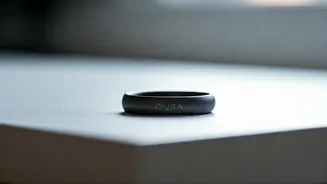Discreet Fitness Revolution
The Indian fitness scene is witnessing a shift towards screenless wearables, transforming the way individuals monitor their health. Devices such as the Whoop
and Oura rings are gaining traction, providing users with a subtle and fashionable means of tracking activity, sleep, and overall well-being. Unlike traditional fitness trackers with prominent displays, these wearables prioritize a minimalist design, integrating seamlessly into daily life without drawing undue attention. This unobtrusive nature makes them particularly appealing to those seeking to blend fitness monitoring with style. The growing popularity suggests a shift away from bulky gadgets towards sleek, design-conscious alternatives that cater to the evolving preferences of the Indian consumer, highlighting a fusion of fashion and functionality.
Whoop vs Oura: Overview
Whoop and Oura ring are two prominent players in the screenless wearable market, both employing advanced technology to deliver comprehensive health insights. The Whoop band, known for its focus on performance and recovery, uses sensors to gather data on strain, sleep, and recovery levels. It is particularly popular among athletes and individuals keen on optimizing their training regimes. Conversely, the Oura ring adopts a more lifestyle-oriented approach, focusing on sleep quality, activity levels, and overall readiness. Its sleek design and discreet form factor make it appealing for those prioritizing style and ease of use. Both devices offer personalized insights, providing users with data-driven recommendations to improve their health habits. Ultimately, the choice between Whoop and Oura often hinges on individual priorities – whether it is deep performance analytics or a more holistic view of well-being.
Why Screenless is Winning
Several factors contribute to the rising popularity of screenless wearables in the Indian market. Their discreet design is a significant advantage, allowing users to track their health without compromising their fashion choices. These devices also appeal to individuals who are concerned about screen time and its potential impact on their mental and physical health. The simplicity of screenless trackers, with data typically accessed via a smartphone app, simplifies the user experience. This user-friendly approach is particularly beneficial for those new to fitness tracking or looking for an effortless way to monitor their health metrics. Moreover, advancements in sensor technology allow these devices to provide remarkably accurate data on a range of health indicators. The convergence of these aspects has driven screenless wearables to the forefront of the Indian fitness technology industry, drawing consumers toward fashionable and effective health management tools.
Tracking Key Metrics
Screenless wearables excel at tracking several key health metrics, providing a wealth of data to users. Sleep quality is a core focus, with devices like the Oura ring analyzing sleep stages, duration, and efficiency to help users understand their rest patterns and optimize their sleep schedules. Activity tracking is another key feature, monitoring steps taken, calories burned, and various workout types. Heart rate variability (HRV) is also tracked, offering insights into stress levels and recovery. These devices are equipped with advanced sensors capable of collecting data round-the-clock, delivering a comprehensive overview of user's overall health and fitness. By providing actionable insights, screenless wearables empower individuals to make informed decisions and maintain an active and healthy lifestyle.
Integration and Insights
The data collected by screenless wearables is typically accessed through a companion smartphone app, where users can view detailed reports, personalized recommendations, and progress tracking. These apps often feature intuitive interfaces that make it easy to understand and interpret complex data. Many devices also offer integration with other health and fitness platforms, allowing users to combine their data with other tools and services, thereby developing a more comprehensive view of their health. The insights offered by these wearables are not limited to tracking; they also include personalized guidance on lifestyle adjustments, such as sleep optimization, workout recommendations, and stress management techniques. By seamlessly integrating data, screenless wearables offer a complete approach to health and wellness, making it easier for users to adopt positive behaviors.
The Future of Fitness
The future of fitness tracking is likely to see the continued evolution of screenless wearables, with devices becoming smaller, more accurate, and more integrated. Advances in sensor technology will enable these devices to track an even wider array of health metrics, from blood oxygen levels to body temperature. Artificial intelligence and machine learning will play a crucial role in providing more personalized insights and recommendations, assisting users to achieve their individual goals. Integration with the healthcare ecosystem will also grow, possibly allowing wearables to be used as tools for diagnosing and managing chronic conditions. As the popularity of screenless wearables continues to grow, we can anticipate a continued focus on user experience, design, and functionality, establishing them as essential components of a healthy lifestyle.












